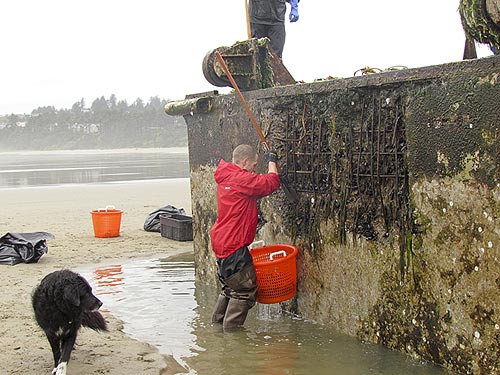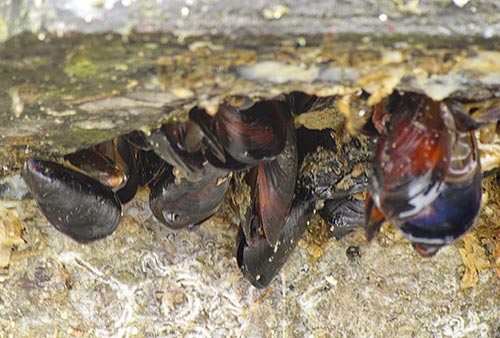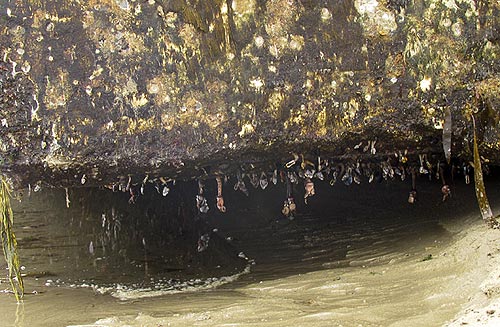 |
Harmful Species Now a Worry on Oregon Coast
Published 06/09/2012

All photos Terry Morse.
(Newport, Oregon) – The dock torn from Misawa, Japan during the devastating tsunami last year has had a few hitchikers on its way to the Oregon coast this week: it has brought with it quite literally millions of unwanted guests. After crews of volunteers scoured the structure clean of little critters remarkably quickly – all accomplished by Thursday - scientists are now scrambling to identify the dozens and dozens of species of marine life that were living on the metal and concrete object and trying to determine what threat may be present from any invasive species. (At top: blow torches are used to sterilize the dock.)
The dock presents many serious questions and startling surprises, and among the most grave are the possibilities that the creatures living on it could pose major risks to ecosystems of beaches, bays and the near-shore waters of the Oregon coast.
John Chapman, a scientist studying invasive species at OSU's Hatfield Science Center in Newport, called it a definite reason for worry, although proving there is an ecological threat could be years away – and it's not for certain.

“Yes, it is very serious,” Chapman said. “But we don't know the magnitude of the risk. It's impossible to say what would or won't happen.”
The numbers alone are shocking. Chapman said the dock itself weighs an approximate 100 tons. But the amount of sea life found on it weighs at least that, according to his team's estimates. There were millions of creatures living on the dock, and what he called “scores of species.”
“There was a wide variety of things,” Chapman said. “Algae, mussels, clams, all kinds of small crustaceans, anthrophods, sponges, tunicates, proto-cordates – a huge diversity of things.”

So far, about 15 species of algae have been identified, 15 to 20 varieties of sponges, and a handful of species of barnacles and other creatures. Chapman said Hatfield scientists are just in the very early stages of figuring out what was living on that structure.
Chapman said they estimate most of the species were from Japan. Of those, a small percentage are species that are known to also live around the Pacific Ocean near both continents. Another smaller percentage has already been introduced to this area.
“About two thirds have never been seen on this coast before,” Chapman said.

That represents a considerable threat. Stiill, Chapman was also quick to caution.
“We don't want to be alarmist, but we are very vulnerable to invasion on this coast,” he said.
Chapman said the Oregon coast has already encountered some bad invasive species in the past, and Yaquina Bay seems to turn up one new species introduction a year.
This dock, however, brought in more new creatures than even a super tanker, Chapman said. And it wasn't just the quantity – but the quality.
“This floating island contained just the kind of species that we fear the most,” Chapman said.
He added that he frequently gets asked what kind of damage these creatures can do to local ecosystems, but he said that's impossible to predict.
“Those animals were found were thriving, they were very healthy, they were reproductive and they were good shape,” Chapman said.
Volunteers quickly and thoroughly scraped off the marine life, and then put a blow-torch to it to sterilize it. What was visible to visitors was not much of an issue. But what worries Chapman and many others is what was not seen and not found.
The bottom of the dock had no sea life on it whatsoever. Chapman said it's impossible for a dock to be without loads of sea life in that area, so experts know an incredible amount was scraped off from the bottom when it scooted onshore at Agate Beach.

“Many, many, many tons fell off this thing when it washed up on the beach,” Chapman said. “Now, that stuff is circulating in the near-shore waters near Yaquina Bay, which is a wonderful place for them if they were thriving.
“Will they survive? We won't know for some time. We may have to wait years.”
Chapman hopes for improved ability to spot large objects like this before they hit the coast so they can more accurately measure potential threats from invasive species.

More About Oregon Coast hotels, lodging.....
More About Oregon Coast Restaurants, Dining.....
 |
 |
LATEST OREGON COAST NEWS STORIES
Oregon Coast, Valley and Likely Washington Coast to Get Some Aurora Borealis ... |
Back to Oregon Coast
Contact Advertise on BeachConnection.net
All Content, unless otherwise attributed, copyright BeachConnection.net Unauthorized use or publication is not permitted
Secrets of the Season |
Unusual Travel Articles TravelParanormal.com allows you to submit your own creepy tale or debunk one - or see up-to-the-minute news headlines about travel and the paranormal. News Headlines from All Over Oregon Need to scan Oregon headlines? Constantly updated news from all over Oregon: a comprehensive, up-to-the-minute display of news headlines from a variety of media |





































